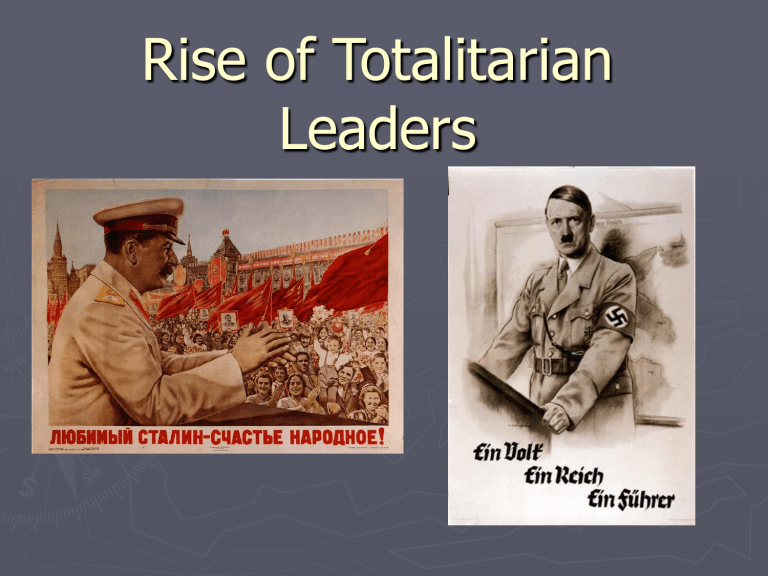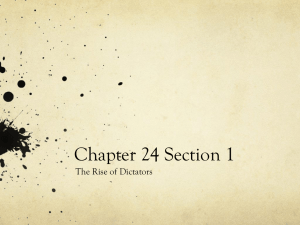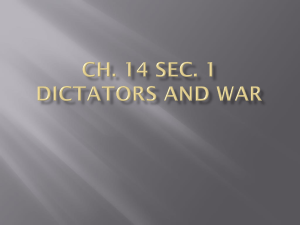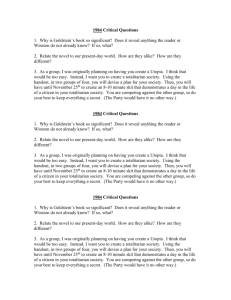Rise of Totalitarian Leaders

Rise of Totalitarian
Leaders
Rise of Totalitarian Leaders
A. European Struggle
1. Economic issues a. Depression- worldwide, not just the
US!
b. Hyperinflation- Germany, 1920s c. Loss of manpower and industry due to
WWI d. Food issues (starvation in Germany)
Rise of Totalitarian Leaders
2. Nationalism a. Extreme love for one’s country
1. Embarrassment for the Germans after the War Guilt clause and reparations.
2. Military restrictions for Germany a. Max 100,000 troops and air force/navy limits
3. Nationalist feelings in England,
France and Italy as well!
Totalitarian Leaders
3. Angry Population a. Bitterness b. Looking for a solution, or an answer c. A return to greatness?
*These new leaders promised economic recovery, military might, and above all, a restoration of pride and hope!
Totalitarian leaders
B. Case Studies
1. ITALY: Rise of Mussolini and Fascism a. Benito Mussolini: a former teacher and journalist b. Created the system of “fascism” c. Fascism- A totalitarian government ruling through unity. The state is more important than any individual!
Fasces
From Latin meaning bundle of sticks –
Romans carried as a symbol of authority and community
Totalitarian Leaders
2. RUSSIA a. Joseph (or sometimes Josef) Stalin b. Communist Revolution- 1917
1. Death of Lenin in 1924
2. Stalin, after a power struggle among other Communist leaders, takes over.
3. Stalin believes in “purging” or killing/imprisoning enemies.
4. Through his rule over 10-12 million people are killed in purges!
Totalitarian Leaders
3. GERMANY a. Adolf Hitler- Joins the Nazi party in
1920 b. Instantly becomes a rising star with his rousing, energetic speeches.
1. 1923- Hitler and followers try to overthrow the democratic German govt.
2. He is arrested and sent to prison
Totalitarian Leaders
3. In jail, Hitler writes his most famous work
Struggle)
Mein Kampf (My a. In this book, Hitler celebrates struggle, German struggle, as a key to future success.
b. Hitler mixes nationalism, fascist ideas, and racism/Darwinism.
c. Hitler capitalizes on anti-Jewish sentiment in Germany!
Totalitarian Leaders
4. Eventually the Nazi party gains power
5. The German President appoints
Hitler as Chancellor (Prime Minister) of the German congress, the
Reichstag. (1933) a. Hitler begins to follow his plans of militarization, nationalist pride, public works projects, and racism.
Totalitarian Leaders c. Hitler’s Racial Policies
1. Believed in racial superiority of the German people (Aryans is a term he used)
2. Wanted to re-establish a German
Empire
3. Anti Semitic- Blamed Jewish people for many of the economic issues in Germany at the time.
Cult of Personality Assign.
►
►
Your job is to create a cult of personality for yourself.
It should show you as:
Powerful, all-knowing, intelligent, kind and loving.
YOU MUST HAVE A MESSAGE (school approp)
You can advertise yourself in a couple of ways
►
Advertisement/Poster
►
►
Poem/Song
Skit
Totalitarian Leaders
C. Totalitarian Military Expansion
1. One of Hitler’s new ideas was the need for “living space.” a. This was a right of a superior people, like the Aryans, according to Hitler.
b. The Germans had the right to expand, especially to include other German speakers.
Maps!!!
►
Map Exercise
Color in Each Totalitarian nation:
Italy
Germany
Russia
Next… let us color in the areas these Totalitarian nations expanded into!











